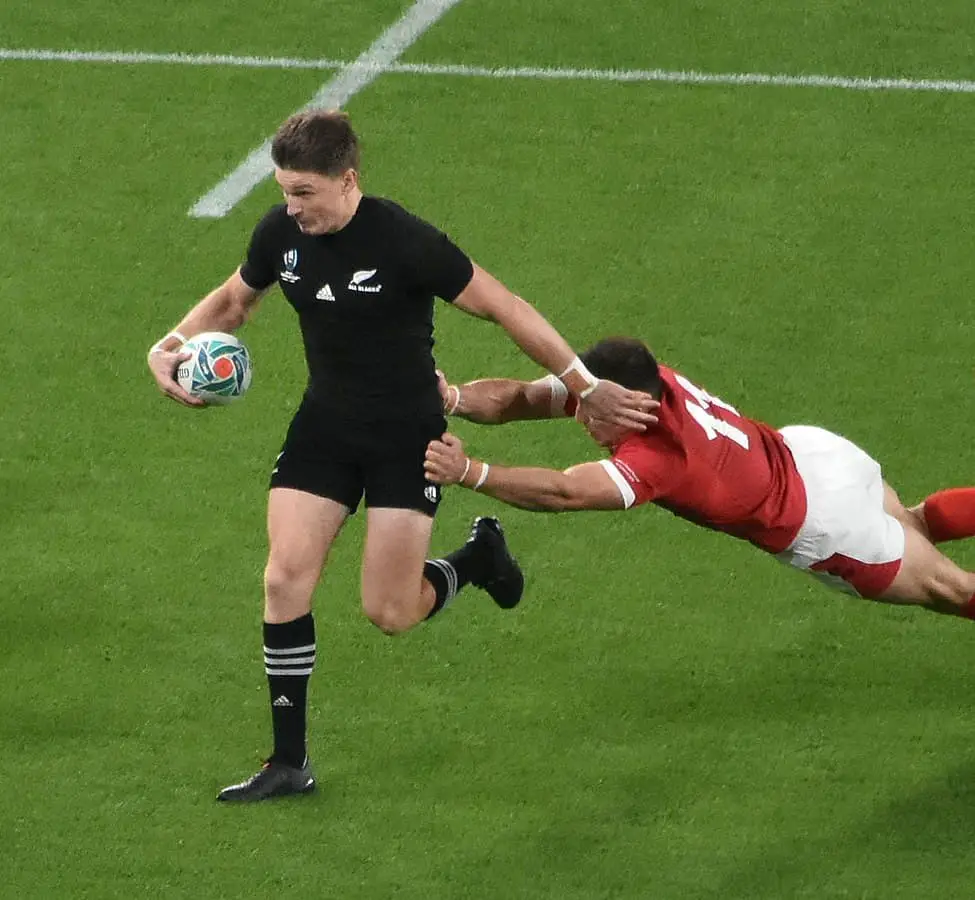Due to the variation between positions in rugby, certain players typically run, on average, far more than other players, depending on their roles within the team. So which rugby positions run the most?
In summary, halfbacks (scrum-halves and fly-halves) run the most during a game averageing 6,620 metres with back row players averaging 6,115 metres per game. However, outside backs sprint the furthest during games but in total cover only 6, 079 metres.
Rugby positions are ranked as follows for average running meters during an 80-minute game:
- Halfbacks (scrum-halves and flyhalves)
- The back row (flanks and number eights)
- Centers
- Outside backs (wings and fullbacks)
- The tight five (props and locks)
Unsurprisingly, the halfback positions of scrumhalf and flyhalf recorded the most meters run in the studies conducted. These positions are essential in linking the play between the forwards and backline, meaning both players need to be present at every single breakdown while also being the starting point for all backline maneuvers.
To better understand the above rankings, we will look at rugby studies published by World Rugby and independent scientific journals to justify these numbers given.
The Difference Between Metres Run And Metres Gained
Before discussing which rugby positions run the most during an 80-minute game, it is important to explain which statistic is not being discussed, namely, that of “meters gained.”
It is crucial to make this distinction because sports pundits, fans, and coaches often focus on meters gained when discussing player and position statistics.
Meters gained measured the distance a player covers when completing a successful carry over the gain line, namely the distance made with the ball in hand and the number of meters the carry produced in reorganizing the offside line to their team (essentially winning territory and making ground in the opposition’s side of the field.)
Consequently, meters gained do not include any run meters without the ball in hand, nor does it include any meters made when a player goes sideways in an attempt to disrupt the opposition’s defense or create a gap.
While meters gained include incremental “pick up and go” movements off the base of a ruck (such as the moves typically performed by the tight five,) this usually only results in a few meters gained as a way of creating space to cleanly execute a backline move.
Instead, the method which results in the most meters gained is off-clean breaks, whereby a play breaks a tackle or goes around the opposition’s defense into clear space. In this instance, a single carry can result in tens of meters, compared to slower forward movements, which may result in zero meters gained per carry.
Therefore, it is common to see the back three positions, like wings and fullbacks, secure the most meters gained, while tight five positions often only achieve single digits despite having more carries.
Paradoxically, wings and fullbacks are not expected to commit to rucks (unless a ruck forms within their sphere of influence or they are performing a long-distance cover tackle), meaning that while they may often achieve the most meters gained, they seldom run the total distance of other positions.
Therefore, this article will focus on the actual run distance of players during a match and not the commonly cited and qualified statistic of “meters gained.”

Also read: Why Are Rugby Players So Fat/Big?
Which Rugby Positions Run The Most On Average?
Two significant studies will be analyzed to determine which position runs the most in rugby. A study conducted by Deutsch et al. J of Sports Sciences in 1998, 2005, and 2006 and a study conducted by Donkin et al. of Frontiers in Psychology in 2020.
The first study, which is cited on the official World Rugby “Strength and Conditioning” page, uncovered the following statistics: (note: this study focused on 70-minute games and not 80-minute games as is standard at the international level.)
Distance Covered By Position
Props and locks (tight five)
Jogging 3050m
Cruising 363m
Sprinting 94m
Total distance 3400m
Back row (flanks and number eight)
Jogging 2940m
Cruising 368m
Sprinting 94m
Total distance 3088m
Backline (all backline positions on average)
Jogging Between 2110m and 2660m
Cruising Between 514m and 565m
Sprinting Between 208m and 297m
Total distance between 3870m and 4010m
The second study conducted by Donkin et al. of Frontiers in Psychology in 2020 uncovered the following statistics from the 2020 Varsity Cup competition in South Africa: (note: Varsity Cup is a semi-professional college level rugby competition with 80-minute games.)
You might want to read: The Average Size of Professional Rugby Players By Position
Total Distance Covered By Position
| Position | Metres run per game |
| Props and locks | 5,352 |
| Back row | 6,115 |
| Half backs | 6,620 |
| Centres | 6,084 |
| Fullback/wing | 6,079 |
In total, the study found that forwards averaged a total distance of 5734m (with a standard deviation of 693m and backline players averaged a total distance of 6261 (with a standard deviation of 745m.)
Although both studies provide different results, there are some notable similarities between two studies, namely:
- Both studies found the tight five to run the least,
- Both studies found that backline players run further on average than forwards.
Curiously, the most significant difference was among the back row, with the 2020 Donkin study finding flanks and the number eight position to run the second most on the field, while the Deutsch studies found the flanks and number eight to run the least!
While the reasons are unknown for this differentiation, further studies coupled with the modern trends of professional rugby suggest the Donkin study be more accurate.
The reason that back-row players run so much is because they are:
- Expected to be one of the first players at mauls and rucks (as they are often specialist poachers)
- Expected to include themselves in backline maneuvers, as well as forward maneuvers,
- Expected to make defensive first-time tackles off set pieces like lineouts and scrums.
Consequently, the modern back-rower is expected to perform a unique hybrid role, whereby they engage in active defensive and offensive maneuvers throughout a game, meaning they often top the list of meters run in a game.
In conclusion, and subject to standard deviation/individual team tactics, the rugby positions that run the most can be ranked as follows:
- Halfbacks,
- The back row,
- Centers,
- Outside backs,
- Props and locks (tight five)
Rugby remains an evolving game that encourages teams to strategically alter their playing styles. Therefore, while certain positions may run more than other positions on average, there is a lot of variation when comparing individual players and teams!
Suggested reading: How far does a rugby player run?
Image Credits
Beauden Barret, famed runner, 江戸村のとくぞう, CC BY-SA 4.0, via Wikimedia Commons
